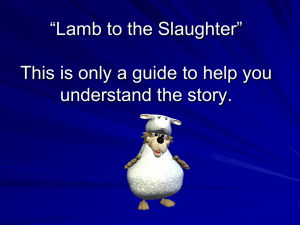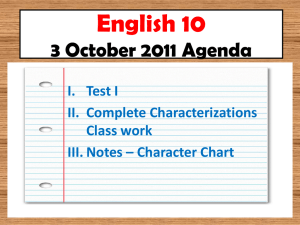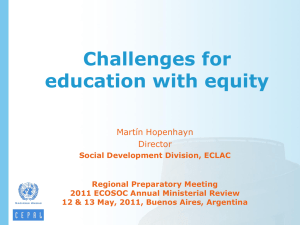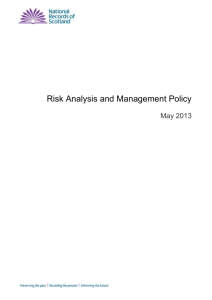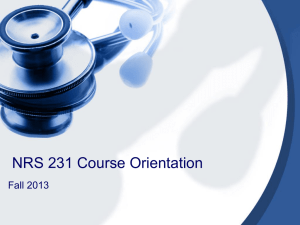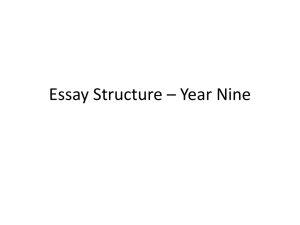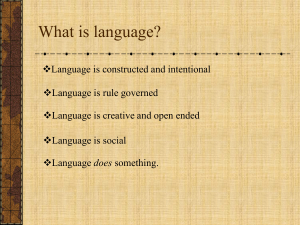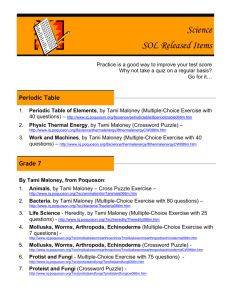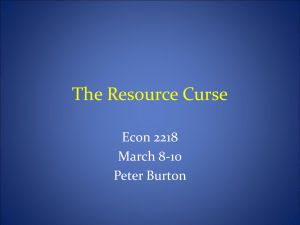Natural Resources: Neither Curse nor Destiny (2007)
advertisement
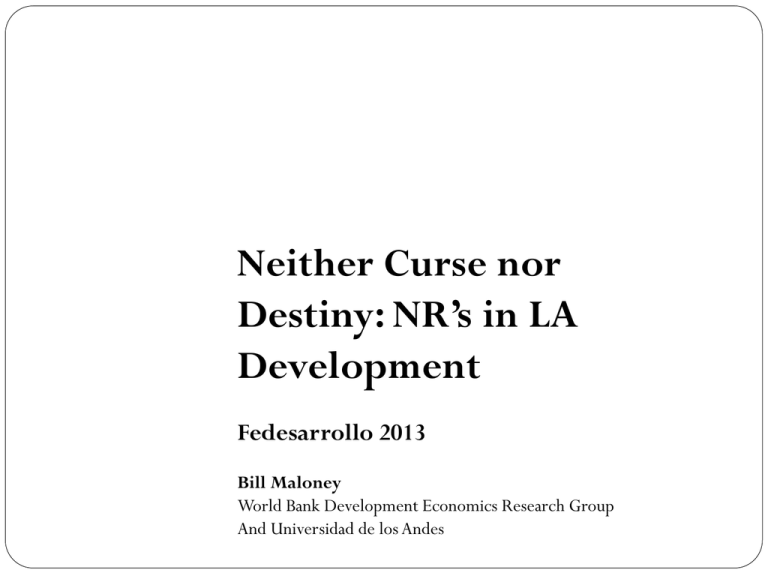
Neither Curse nor Destiny: NR’s in LA Development Fedesarrollo 2013 Bill Maloney World Bank Development Economics Research Group And Universidad de los Andes Based on: Does What you Export Matter? (2012, forthcoming, Los Andes) Engineers, Innovative Capacity and Development in the Americas (2012) In Search of the Elusive Resource Curse (2009) Natural Resources: Neither Curse nor Destiny (2007) Missed Opportunities: Innovation and Natural Resources in Latin America (2007) www.worldbank.org/wmaloney Introduction to Innovation Policy • June 14-18, 2010 – Washington, D.C. The missing resource curse: no negative growth effect on average Most cited resource curse findings fragile (eg. Sachs and Warner) Lederman & Maloney (2007, 2008), Alexeev and Conrad (2009) Subsoil mineral wealth endowments robustly correlated with growth: Davis (1995), Sala-i-Martin et al. (2004), Stijns (2005), Brunnschweiler (2008, 2009). Higher commodity prices raise growth Deaton and Miller (1995), Raddatz (2007) for poor countries. NRs: Not cursed.. but they do have “issues” 1. Governance, 2. Concentration, 3. Productivity/dynamism Introduction to Innovation Policy • June 14-18, 2010 – Washington, D.C. NR Issues: Low productivity/growth Smith (1776), Matsuyama (1996), Sachs et. al (1995 to 2001) Rationale for Dutch disease concern (aid too) Rich Country Goods better Hausmann, Hwang, Rodrik 2007, Lall 2007 Country should produce the highest productivity good within its CA PRODY, EXPY correlated with higher growth. Introduction to Innovation Policy • June 14-18, 2010 – Washington, D.C. NRs have very mixed PRODYs.. 35000 30000 25000 20000 15000 10000 5000 0 PRODYs (with +/- 1 SD*) Low productivity/ ME Demand side Rodriguez-Clare critique Are rents higher where rich countries already are? If easy to move into these goods, then barriers to entry/rents low; ditto MNCs permanence Introduction to Innovation Policy • June 14-18, 2010 – Washington, D.C. But the Key- to understand the heterogeneity of experience 10 Greec e K orea, R Log GDP per capita 1990 Leamer Measure: Net Exports of NR/Worker U nited S S w itz erl France H ong KJapan onU Germany nited K A us tria Italy Israel S pain C yprus 9 P oland V enezuel Mex ic o Malay sia S yrian A A rgentin U ruguay C hile B razil Iran, Is Gabon C osAta outh f Ri Thailand CS olombia A lgeria E cuador C ongo, D Jamaica Guatemal P araguay P eru D ominica Indones B oliviai Mauritiu H ungary Turk ey Fiji Jordan Tunisia P anama Moroc co alv a E gy pt, AESl riSLank P hilippi 8 C ape V er anglade P ak isB tan S enegalIndia 7 B urkina H onduras P Capua ote d'N I e C ameroon Zimbabw e N igeria K enya Guy ana Ghana S ierra L R w anda Mauritan Guinea Zambia Madagasc Togo C omoros ganda BU urundi Malaw i N icaragu C hina B enin Gambia, Moz ambiq Guinea-B C anada S w eden N orw ay A us trali Finland Iceland D enmark N etherla N ew Zeal Ireland S udan Mali C had 6 -11.5041 Resource Scarce Maloney 2007 11.7949 Log Natural Resources (Leamer) Resource Abundant Historically, natural resources have been a dynamic source of growth, but not in LA Agriculture Productivity growth is higher in agriculture than manufactures (Bernard and Jones 1996, Martin and Mitra 2001) But not in LA (or LDCs more generally) Forestry Dynamic in Finland, Sweden Moribund in Brazil, Chile until late 20th century Mining Foundation for sustained prosperity in Australia, Canada, US Latin America: “mineral underachievers” (Wright 2007) True enclave economies Introduction to Innovation Policy • June 14-18, 2010 – Washington, D.C. Ancient History: Mining Same good, different outcomes Mexico, Chile in 1800 were dominant global powers in Mining but nearly dead by 1900 US experience with exactly the same goods exactly the opposite. US dominates mining in Mexico, Chile-Able to employ and perfect the Bessemer process, leverage human capital accumulation Wright (1987) - US Copper industry-an example of national learning as a network effect. Not product mix-LAC unprepared for the 2nd industrial revolution (See Does what you export matter?- Lederman and Maloney 2012) Introduction to Innovation Policy • June 14-18, 2010 – Washington, D.C. Innovative/Entrepreneurial capacity the driver? Introduction to Innovation Policy • June 14-18, 2010 – Washington, D.C. Density of Engineers~ 1900 Quintil Bajo Quintil 2 Quintil 3 Quintil 4 Quintil Alto Source: Maloney and Valencia (2013) Any formalizations? Aghion, Howitt, Mayer (2005), Howitt and Mayer-Foulkes (2005). Invention, Adoption Stagnation Eqs Depends on “frontier adjusted human capital” (relative innovative capacity) Low HC- can slip into a stagnation eq. when tech advance occurs. LAC Mining-slipped into stagnation eq. Antioquia-actually maintained/increased HC Asia: struggle to reach increase HC and better eq. Huge literature on building firm capacity, ability to learn. Introduction to Innovation Policy • June 14-18, 2010 – Washington, D.C. Hausmann: NRs as isolated trees? Theoretically, does it matter if monkey climbing one very tall tree vs jumping among trees? Diversification? Demand side? Rodriguez (again): being a tree in a dense area is like a ME If easy to jump from one tree to others, then easy to jump to.. Quality ladders: better to jump to goods that don’t exist yet The past as predictor? With death of distance, past NR monkey jumps may not happen-Steam Engine, Saab, Nokia What will new adjacent products be? Introduction to Innovation Policy • June 14-18, 2010 – Washington, D.C. Hot High Tech products on RT 128why not Chile? Frankenfish Splice in growth gene from Ocean Pout (eel) Salmon grows twice as fast as normal AquaBounty Maynard, MA Better trees, or better monkeys? Scandanavia’s Forestry Cluster Nokia: Site of an early pulp mill in Finland Learn how to learn 4/8/2015 Managing risk: lessons from unit values Quality measure by price/unit value Huge variance within products (Schott 2004) Average quality rises with development Low possibilities for UV growth in NR (Hwang) Yes, there is convergence But are quality ladders shorter? Yes for most, but not for metals Introduction to Innovation Policy • June 14-18, 2010 – Washington, D.C. NRs do seem to show a lower riskreturn combination Figure 4: Unit Values: Drift and Standard Deviation, Country Fixed Effects, HS-1 1990-2001 0.18 machinelec (84-85) 0.16 0.14 Drift (Product Dummies) misc (90-97) 0.12 transp (86-89) 0.1 leatherprods (41-43) 0.08 stoneglass (68-71) woodprods (44-49) foothead (64-67) minerals (25-27) animals (01-05) 0.06 vegetables (06-15) plasticrubber (39-40) textiles (50-63) chemallied (28-38) 0.04 metals (72-83) foods (16-24) 0.02 -0.2 -0.1 0 0.1 Standard Deviation (Product Dummies) Krishna and Maloney 2009 0.2 0.3 But again… the how matters Figure 4: Quality Growth by Region 1990-2001 (Product Fixed Effects Included) 0.004 Median Quality Growth 0.002 0 -0.002 -0.004 OECD (highincome) LAC MENA EASIAP (highincome) SASIA -0.006 -0.008 -0.01 -0.012 -0.014 Region Krishna and Maloney (2009) SSAFRICA EASIAP (low income) EUROPE (nonOECD) CASIA NR issues: Harnessing their dynamic potential How get the most out of extractive industries themselves? How leverage NRs to generate new industries- diversification? Choice: Enclave with limited development effects or Provide foundation for economic dynamism. Critical element: development of national learning/ innovative capacity Management of risks of entering new sectors/techniques Introduction to Innovation Policy • June 14-18, 2010 – Washington, D.C. Innovation/Learning capacity seems key to lifting LAC’s game The variance in development impact around any particular production basket is large The focus on particular goods (trees/forests) diverts attention from more important issue: LAC needs better Monkeys. Asia has been training (networks of) Monkeys for decades. China struggling now Middle income trap? Countries exploit simple rents (NR, cheap labor) and then can’t make the transition to adopting or invention eqs.? Introduction to Innovation Policy • June 14-18, 2010 – Washington, D.C. Fin
